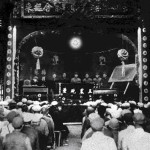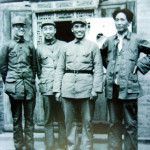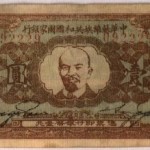
The Jiangxi Soviet, later called the Chinese Soviet Republic, was a self-governing region under Chinese Communist Party (CCP) control during the early 1930s. Established by Mao Zedong and the Red Army in 1930, the Jiangxi Soviet was significant for a number of reasons. It provided the CCP with a regional stronghold where it could consolidate and strengthen the Red Army. The Jiangxi Soviet was also a social and economic laboratory for trialling peasant-based socialism. The Jiangxi period thrust Mao Zedong into prominence as a CCP leader, as well as providing insight into his military tactics and political ideology. Jiangxi also exposed Mao’s cunning and brutality: his control was secured and maintained through violent purges of local communists. The flourishing Jiangxi Soviet caused concerns for Jiang Jieshi and his right-wing nationalist government in Nanjing. Fearful the CCP might use Jiangxi as a revolutionary base, Jiang launched several offensives against the region – but the first four of these were blocked by the renewed Red Army, employing guerrilla strategies developed by Mao and his lieutenants. Guomindang forces eventually surrounded Jiangxi in 1934, forcing the Red Army and CCP cadres to break out of the region and begin their famous Long March to the safety of northern China.
The Jiangxi Soviet was formed by Chinese communists who viewed the peasantry, the nation’s largest and most impoverished class, as the natural source of revolutionary action. The main exponent of this idea was Mao Zedong, a Hunan-born teacher and writer who was himself from peasant stock. Mao was a founding member of the CCP and a supporter of Marxist theory, however, his own political views were eclectic and not rigidly Marxist. In September 1927 Mao, ignoring directives from the CCP’s central committee, initiated a peasant uprising in his home province of Hunan. The Autumn Harvest Uprising, as it was called, was a short-lived attempt to overthrow Hunan’s provincial government and create a communist Soviet there. The uprising failed to attract sufficient support and Nationalist regiments forced Mao’s peasant militia into hiding in Jinggangshan, a remote mountain range between eastern Hunan and western Jiangxi. There they met with other CCP armies commanded by Zhou Enlai and Zhu De, who had retreated to Jinggangshan after the failed Nanchang Uprising in northern Jiangxi. Together these communist forces comprised the nucleus of the CCP’s Red Army – though at this stage they were a disorganised collection of rebellious peasants, communists, bandits and deserters from warlord armies and the Guomindang.

In 1929 Nationalist offensives forced most of the communists out of Jinggangshan. Led by Mao and Zhu De they moved into southern Jiangxi, basing themselves around the city of Ruijin. With further Nationalist attacks imminent, Mao set about strengthening the Red Army. Assisted by Zhu De, Mao devised plans for reorganising, training and preparing communist troops in Jiangxi. A voracious reader in his youth, Mao had studied the lives and victories of many great commanders, from Alexander the Great to George Washington – but it was the teachings of ancient Chinese general Sun Tzu that impressed him most. In his famous The Art of War, Sun Tzu emphasised the military value of speed, deception, concealment and morale; his credo “avoid what is strong, attack what is weak” formed the basis of what we know today as guerrilla warfare. Mao embraced these tactics and worked to incorporate them into the Red Army. Large divisions were organised into smaller guerrilla-based regiments, capable of operating autonomously. Mao also implemented a Leninist command structure and placed political commissars in army units to report on discipline, political attitudes and morale. A Red Army school was established in Jiangxi where CCP instructors, many of them veterans of the Huangpu Military Academy, drilled officers on tactics, leadership and modern warfare techniques, such as communications and code-breaking. In just a few years the Red Army hardened from a rag-tag peasant militia into a well trained and competent military force.

The Jiangxi Soviet became a political entity as well as a military base. The formation of this ‘state within a state’ provided the CCP with valuable experience in running a government. The Soviet was officially formed in November 1931, when 15 CCP-controlled settlements around Ruijin were amalgamated into a new independent state called Zhonghua Suwei-ai Gongheguo, or the Chinese Soviet Republic. The government of this new republic was modelled on the Soviet government formed in Russia after the October 1917 revolution. An executive committee was elected to oversee policy and appointments, while a smaller commissariat oversaw day to day government. Mao Zedong was elected chairman of both bodies, in addition to his duties as Jiangxi’s military commander. He would later be sidelined from power after the CCP hierarchy relocated from Shanghai to Jiangxi. The Chinese Soviet Republic also adopted its own flag, the Soviet Union hammer and sickle on a red background, and drafted its own constitution, which read in part:
“The Chinese Soviet regime is a state based on the democratic dictatorship of the workers and peasants. All the power of the Soviet shall belong to the workers, peasants and Red Army soldiers and the entire labouring population. Under the Soviet regime, the workers, peasants, Red Army soldiers and entire labouring population shall have the right to elect their own deputies to give effect to their power. Only militarists, bureaucrats, landlords, the despotic gentry, capitalists, rich peasants, monks and all exploiting and counter-revolutionary elements shall be deprived of the right to elect deputies to participate in government and to enjoy political freedom…”
In keeping with this vision, Mao and his supporters initiated ambitious economic reforms in Jiangxi. In 1930 the Soviet government ordered that all surplus land be confiscated from landlords and affluent peasants, then handed to villages for redistribution. The process did not punish landlords or rich peasants, who like all others were entitled to ownership of land. Mao’s view was that declaring war on landlords ‘wasted’ revolutionary energy. He preferred a more inclusive approach that encouraged co-operation and production, rather than provoking internal disruption. Land policies in the Chinese Soviet Republic shifted radically in 1933 when Mao’s leadership was overtaken by the Comintern-backed Shanghai leaders. Post-1933 land policies in Jiangxi began to resemble those employed in Stalinist Russia. Land redistribution was controlled by the party centre, more closely monitored and conducted more ruthlessly. Landlords and wealthy peasants were excluded or given poor quality land; hundreds were persecuted, driven into exile or murdered. The CCP central executive condemned Mao’s land policies as too moderate and bourgeois – yet under Mao’s leadership, agrarian production in Jiangxi had steadily increased. At its peak in around 1932, the Jiangxi region was outdoing most other Chinese provinces in terms of food production.
“The Jiangxi Soviet Republic afforded the Communists the first opportunity to test their ability to govern… Mao Zedong deliberately used the Jiangxi Soviet Republic to counter-balance his opponents who were in control of the Party organisation. However it did not last long, and Mao’s dominance of it was even shorter.”
Shiping Zheng, historian
Mao’s leadership also had its dark side. Jiangxi had its own CCP framework before Mao and his followers arrived in 1929. The Jiangxi communists followed the party line, articulated by the CCP leadership in Shanghai. Mao’s takeover of the Ruijin area and his formation of a peasant-based soviet triggered political disagreements and tensions between the Jiangxi CCP and Mao’s followers. These tensions came to a head during the so-called Futian incident. In December 1930 Mao ordered the arrest of around 4,000 Red Army personnel, claiming some regiments had been infiltrated by Guomindang agents. These arrests triggered the mutiny of a Red Army battalion in Qingyuan, central Jiangxi. Mao’s lieutenants Peng Dehuai and Lin Biao responded by marching Red Army units into Futian and crushing the mutiny. Approximately 700 communist soldiers were rounded up, interrogated and executed. Mao and his supporters continued the purge into 1931, justifying them with ongoing threats from Guomindang spies and informers. The historians Jung Chang and Jon Halliday claim this political violence was designed to consolidate Mao’s power by exterminating and dispersing local Jiangxi communists. According to Chang and Halliday, Mao’s henchmen employed quite horrific methods of torture, both against political opponents and their wives and families.

Unsurprisingly, the nationalist-militarist leader Jiang Jieshi viewed the Jiangxi Soviet as a threat to his own government. Between 1930 and 1933 Jiang ordered four offensives, dubbed Encirclement Campaigns, against the communists in Jiangxi. The first of these campaigns were unsuccessful: they required Nationalist forces to travel long distances from their bases into the interior of China, stretching their command and supply lines. Red Army divisions, which were growing in skill and confidence, were able to isolate and engage Guomindang forces using Mao’s guerrilla strategies. In the First Encirclement Campaign (1930-31) several Nationalist divisions were surrounded by the more mobile Red Army and around 12,000 soldiers were taken prisoner. Jiang’s Second and Third Encirclement Campaigns, both launched in 1931, employed much larger troop numbers (around 100,000 Nationalist soldiers and 200,000 warlord soldiers) but they also failed to drive the CCP from Jiangxi. In the autumn of 1933 Nationalist forces began their final assault, the Fifth Encirclement Campaign. This time Jiang was much better prepared, both with resources and strategy. The Nationalist armies boasted around 800,000 men, dozens of heavy artillery pieces and 200 aeroplanes. Nationalist generals were armed with battle strategies for countering Red Army mobility, drawn up with the assistance of German military advisors, particularly Hans von Seeckt. These advantages, coupled with a shift in CCP military tactics, allowed the Nationalists to finally drive the communists from their stronghold in Jiangxi.

1. The Jiangxi Soviet was a self-governing communist region, formed around Ruijin by Mao Zedong and the Red Army in 1930. They arrived there after the failed Autumn Harvest Uprising of 1929.
2. In November 1931 the Jiangxi Soviet became the Chinese Soviet Republic. It adopted its own constitution and served as a laboratory for socialist policies, particularly land reform and redistribution.
3. Within the Jiangxi Soviet, the Red Army was restructured, renewed and trained in guerrilla strategies, studied and adapted by Mao Zedong.
4. Between 1930 and 1934 the Jiangxi Soviet was attacked by the Nationalist forces of Jiang Jieshi, in five offensives known as Encirclement Campaigns.
5. These early offensives proved unsuccessful, however by late 1933 the Red Army was finally driven out after being outnumbered, outgunned and undermined by changes in tactics.
© Alpha History 2018-23. Content on this page may not be republished or distributed without permission. For more information please refer to our Terms of Use.
This page was written by Glenn Kucha and Jennifer Llewellyn. To reference this page, use the following citation:
G. Kucha & J. Llewellyn, “The Jiangxi Soviet, Alpha History, accessed [today’s date], https://alphahistory.com/chineserevolution/jiangxi-soviet/.
This website uses pinyin romanisations of Chinese words and names. Please refer to this page for more information.
